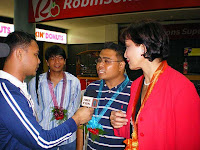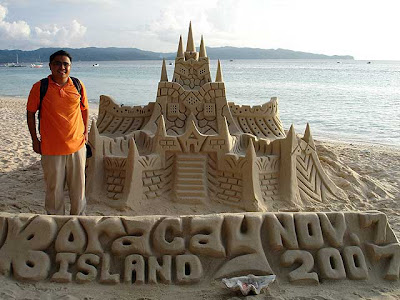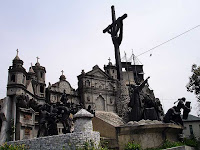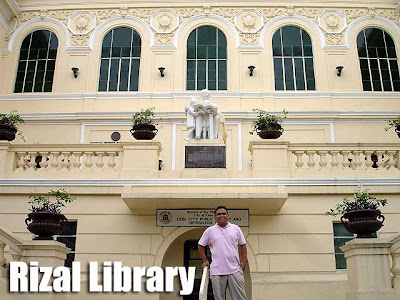 The day after the conference, we visited the towns of Southern Iloilo and Antique, my 59th province. From the hotel, we took a van and stopped by the towns of Tigbauan and Guimbal, which I was not able to visit during my previous visit, to check out their churches. We then proceeded to the UNESCO World Heritage Site, the Miag-ao Church and the cemetery chapel, also in the same town.
The day after the conference, we visited the towns of Southern Iloilo and Antique, my 59th province. From the hotel, we took a van and stopped by the towns of Tigbauan and Guimbal, which I was not able to visit during my previous visit, to check out their churches. We then proceeded to the UNESCO World Heritage Site, the Miag-ao Church and the cemetery chapel, also in the same town.
 In the next town was a National Cultural Treasure, the San Joaquin Church. But equally impressive was the well-preserved cemetery which has maintained its old and uncrowded look.
In the next town was a National Cultural Treasure, the San Joaquin Church. But equally impressive was the well-preserved cemetery which has maintained its old and uncrowded look.From there, we drove down to Antique. But we stopped over first at the junction point called Tiolas to have lunch. I got myself an order of batchoy. From there, we took the road less traveled to the southernmost point of Panay Island, the town of Anini-y.
 The Anini-y Church was very much intact and I hope that it is declared a National Cultural Treasure soon. It was most definitely worth the visit.
The Anini-y Church was very much intact and I hope that it is declared a National Cultural Treasure soon. It was most definitely worth the visit. Our companions had to drive back to Iloilo City since they were leaving that night, but Archt. Richard Bautista and myself opted to stay behind to continue further up north to visit the other towns of Antique. Transportation was scarce and we had to wait for 30 minutes for the next jeep to arrive. Our next stop was the town of Hamtic since the cemetery chapel there was quite intact.
Our companions had to drive back to Iloilo City since they were leaving that night, but Archt. Richard Bautista and myself opted to stay behind to continue further up north to visit the other towns of Antique. Transportation was scarce and we had to wait for 30 minutes for the next jeep to arrive. Our next stop was the town of Hamtic since the cemetery chapel there was quite intact.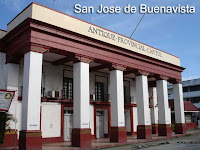 From Hamtic, we took another jeep to the capital of Antique, San Jose de Buenavista. After taking photos around the Antique Capitol, we rushed to get a jeep to Patnongon to check out more heritage structures there. Although in ruins, the church, casa real and an old bridge are still standing and I hope it remains that way. We had to rush back to San Jose to try to get a bus back to Iloilo City. If we got stranded in Antique, we were prepared to stay for the night. But good thing we were able to find a bus back and got back to Iloilo City.
From Hamtic, we took another jeep to the capital of Antique, San Jose de Buenavista. After taking photos around the Antique Capitol, we rushed to get a jeep to Patnongon to check out more heritage structures there. Although in ruins, the church, casa real and an old bridge are still standing and I hope it remains that way. We had to rush back to San Jose to try to get a bus back to Iloilo City. If we got stranded in Antique, we were prepared to stay for the night. But good thing we were able to find a bus back and got back to Iloilo City.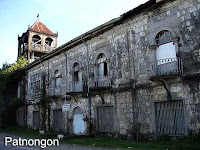 The next day, it was raining hard so I was too lazy to get up. Our plan was to go around Central Iloilo. But we decided to continue our church and cemetery tour since it looked like the weather was improving.
The next day, it was raining hard so I was too lazy to get up. Our plan was to go around Central Iloilo. But we decided to continue our church and cemetery tour since it looked like the weather was improving.From the hotel, we took a cab to La Paz for lunch. Where else to try batchoy than where it was born! We ate at Deco's. From there, we took a jeep to Jaro, where we boarded another jeep to Cabatuan. We got off at the cemetery a few kilometers from town. The walls and chapel was still intact.
 We then took a tricycle to the town proper. The church was gargantuan with two exaggeratedly large belfries on either side of the facade. Its stone retablo is said to be the tallest in Iloilo after the Oton Church was destroyed during the 1948 earthquake.
We then took a tricycle to the town proper. The church was gargantuan with two exaggeratedly large belfries on either side of the facade. Its stone retablo is said to be the tallest in Iloilo after the Oton Church was destroyed during the 1948 earthquake.From Cabatuan, we took another jeep to Janiuay. After visiting the ruins of the church, we took a tricycle to the cemetery. I've seen photos of this all the time but was quite disappointed when I got there. It was quite neglected. To me, the best cemetery I visited is the one in San Joaquin which I heard was recently restored.
 From Janiuay, we took a jeep to Pototan and transferred to another jeep to Dingle to visit the church. Good thing there was English Mass.
From Janiuay, we took a jeep to Pototan and transferred to another jeep to Dingle to visit the church. Good thing there was English Mass.We were planning to visit Duenas but since we had a flight to catch, we took a jeep straight to Iloilo City. They sure know how to stuff the jeepney! There were three passengers in front plus the driver, thirteen on either side, plus about eight in the middle, and even some holding on outside!
 In Iloilo City, I took some photos in Jaro before we proceeded for a quick dinner in one of the chicken inasal restaurants. It was then a mad rush to the airport and we got there just in time since I got my favorite front row seat. Hehe!
In Iloilo City, I took some photos in Jaro before we proceeded for a quick dinner in one of the chicken inasal restaurants. It was then a mad rush to the airport and we got there just in time since I got my favorite front row seat. Hehe!


